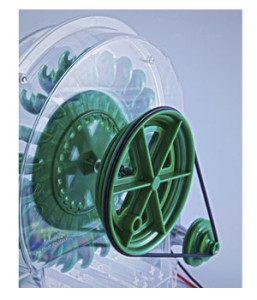 by: Ken Crawford
by: Ken Crawford
As I mentioned in my last blog, I had the opportunity to get in on the ground floor of introducing a new teaching tool called the PowerWheel. As a career social studies teacher and administrator, it has been a great experience to learn about a whole new area of academics…the teaching of energy and everything that goes along with it.
As we started to market the PowerWheel, one of the first things that we did was to bring together a group of teachers that represented all teaching levels…from the elementary to the post-secondary. Many of these teachers were not science teachers…or had limited science backgrounds. After giving them the chance to use the PowerWheel, we asked them, “How can we make the PowerWheel the most effective teaching tool it can be?”
Their answers were an eye-opener for us. It came down to variations on a single theme: Before we can use the PowerWheel effectively, we need to understand energy ourselves…then we can teach our students. It turns out that one of the greatest fears or limitations that some of the teachers had was the lack of their own knowledge. If given a chance to choose between a social studies lesson and a science lesson…they would choose the former…just because of comfort level.
From that moment on, we knew that we had an additional priority…help teach the teachers, and then effective learning about energy could take place. The PowerWheel is a great tool to help do this…easy to understand, and easy to use.
Here are three thoughts about teaching energy education in your classroom:
1. Realize that you don’t need to know everything about energy in order to teach about it.
There are some basic concepts that are easy to learn…and depending upon the grade level and ability of your students, that will be enough to get a great discussion started.
Our suggestions:
- Learn some simple energy definitions: Energy, Potential Energy, Kinetic Energy, Mechanical Energy, Electrical Energy, Radiant Energy, Chemical Energy.
- Learn the concept of the conversion of energy. There are examples of energy conversion all around us once you know the concept. A tool like the PowerWheel is great for this because you can demonstrate a variety of different conversions of energy that your students can see.
- Find the experts in your local, school and educational community. For example, we provide free in-service to those teachers that purchase a PowerWheel. Most local public utility districts have access to learning resources. In some instances, they may actually have an education service that they can provide to your school or classroom at no cost. Find out who provides energy services in your community and contact them.
2. When you do teach about energy, make the kids do the work.
Teaching about energy shouldn’t be all lecture or teacher directed. Energy education is made for discussion and questions and exploration. Use questioning and thinking strategies that help students learn to observe, comprehend and analyze what they are seeing. We recommend that you go back and take a look at Bloom’s Taxonomy. Re-discover the different levels of critical thinking…and the vocabulary that you can use in helping students move up to higher levels of thinking…give them the basics (knowledge/comprehension) , but then help guide them to the higher levels of critical thinking (synthesis and evaluation). Ask the question “Why?” a lot.
3. Make it relevant.
If there ever was a topic that lends itself to something important in our world today, it’s energy and its use. Develop your “energy awareness”. There are energy issues around us all the time. Becoming aware of issues of sustainability, energy renewal, hydro-electric power, how energy is delivered etc., makes it a topic of ongoing relevance. And most important, Have Fun!
Ken Crawford first began teaching in 1975. He has been a teacher, coach and administrator at the junior high, high school and post-secondary levels. He continues to teach at the community college and university levels including supervision of student teachers interested in entering the profession. He also serves as the Director of Marketing and Learning Resources for RB Manufacturing-the producer of the PowerWheel.
